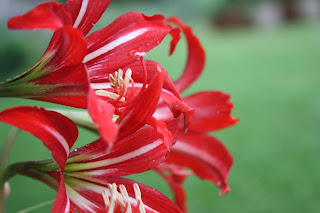St. Joseph's Lily is Hippeastrum johnsonii
St. Joseph’s Lilies have been blooming around town since
late May. They are one of the few Amaryllis that are cold hardy enough to be
grown outside in our area. Other names include Hardy Amaryllis and Johnson’s
Amaryllis
Hippeastrum Johnsonii is named for the plant breeder, watchmaker
Arthur Johnson of Lancashire, UK, who created the first St. Joseph’s Lily in
1799. The parent plants were Hippeastrum reginae (from Peru) and Hippeastrum vittatum
(from Brazil). Many other Lilies have been introduced but this one remains a
favorite for gardeners who enjoy heritage plants with.
Johnson shared his new lily with the Liverpool Botanic
Garden shortly before his greenhouses were destroyed and his original bulbs
lost.
Its cold hardy zones are from 6 to 12 (we are zone 7) so
it is often grown as a potted plant by gardeners farther north. Outside it
wants sun to part-shade and like all bulbs, needs well-drained soil.
The flowers are red, bell-shaped with a white stripe. The
throat of each flower is green. Each 1-2 foot tall stalk typically has four
flowers, sometimes six. When grown indoors (forced with artificial light and
heat) the stalks can grow very tall. Outside, in full sun the stalks will be
closer to 8-inches tall.
After the flowers fade, seed pods form. The pods can be
collected and the fresh seed planted directly into pots. Stored seeds will be
less viable with slower and lower germination rates.
The leaves are strap-like, resembling other lilies. In
areas where there is no hard freeze, the plants are evergreen all year. In
full-sunlight the leaves take on a copper tone.
Howard Garrett, The Dirt Doctor (www.dirtdoctor.com),
calls them the tulip of the south. They give us the bright red color we crave
on cloudy spring days but do not require the prolonged cold weather that
Holland-grown tulips need in order to bloom.
St. Joseph Lilies were offered in the US by 1853 but
today few companies carry them. They have become pass-along plants, so while
they are blooming, this is a good time to stop and ask for a bulb or two
wherever you see them growing.
St. Joseph’s Lily bulbs are available from Bayou City
Heirloom Bulbs in TX (http://bayoucityheirloombulbs.com). Owner Patty Allen
said, “These bulbs were rescued from old homesteads. They are not from tissue
culture.”
Another source, Brent and Becky’s Bulbs (https://store.brentandbeckysbulbs.com) says
they will form clumps after the first two years in the ground.
Around town, there are several large clumps visible in
older home gardens. The bulbs that were given to us by a gardening friend came
from a 40-foot-long row that had expanded over 20-years.
Bulbs are divided after flowering in the spring or in the
fall. Plant the bulbs in loosened, amended soil with the bulb neck above ground
level. When deciding where to plant the bulbs, give them plenty of room. The
leaves can grow to 30-inches long and 1.5 inches wide.
Plant Delights Nursery (www.plantdelights.com) offers
alternatives. 1) Hippeastrum 'Charisma' (Charisma Hardy Hippeastrum) which is a
solid red that resembles a red daylily; and, 2) Hippeastrum 'Voodoo' (Naughty
Lady Amaryllis) closely resembles St. Joseph’s Lily but without the bright
white stripe. They also have survived below zero temperatures at their zone 7
garden.
St. Joseph’s Lilies and all Hippeastrums are members of
the Amaryllidaceae or onion family, making them deer and rabbit resistant.
In “Heirloom Gardening in the South” by Dr.
Bill Welsh and Greg Grant, Grant said, "Without a doubt, Johnson's hybrid
is the finest Amaryllis for garden culture in the South. The combination of the
brilliant red flowers, spicy fragrance, and it’s unbelievable toughness makes
it a bulb without equal".




Comments
Now, it they just bloomed for 3 months instead of one....